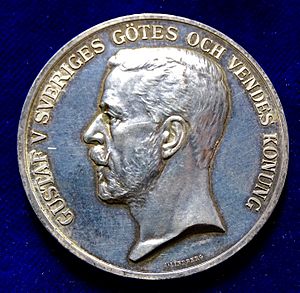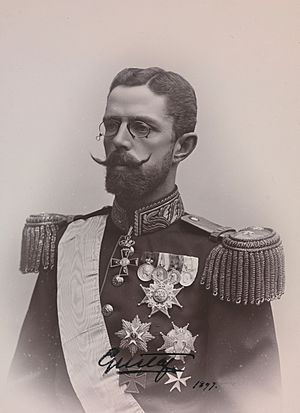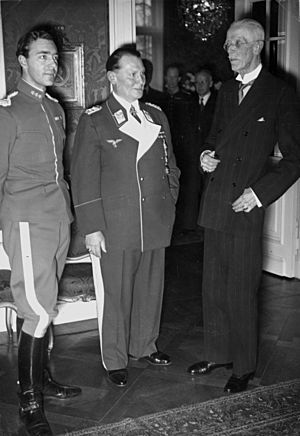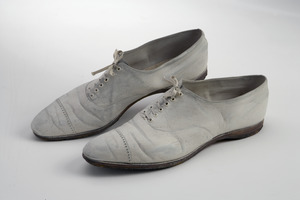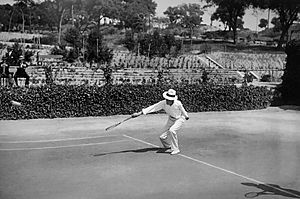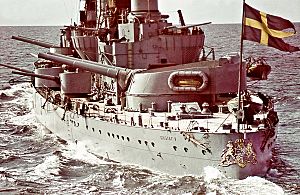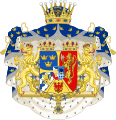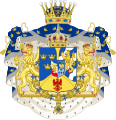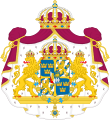Gustaf V facts for kids
Quick facts for kids Gustaf V |
|||||
|---|---|---|---|---|---|
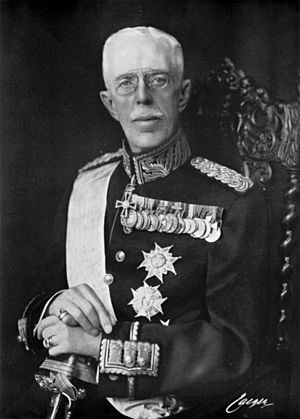
Gustaf V in 1938
|
|||||
| King of Sweden | |||||
| Reign | 8 December 1907 – 29 October 1950 | ||||
| Predecessor | Oscar II | ||||
| Successor | Gustaf VI Adolf | ||||
| Prime ministers | |||||
| Born | 16 June 1858 Drottningholm Palace, Stockholm, Sweden |
||||
| Died | 29 October 1950 (aged 92) Drottningholm Palace, Stockholm, Sweden |
||||
| Burial | 9 November 1950 Riddarholmen Church |
||||
| Spouse |
Victoria of Baden
(m. 1881; died 1930) |
||||
| Issue |
|
||||
|
|||||
| House | Bernadotte | ||||
| Father | Oscar II of Sweden | ||||
| Mother | Sophia of Nassau | ||||
| Religion | Church of Sweden | ||||
Gustaf V (born Oscar Gustaf Adolf; 16 June 1858 – 29 October 1950) was the King of Sweden from 1907 until he passed away in 1950. He was the oldest son of King Oscar II of Sweden and Sophia of Nassau.
Gustaf V ruled for nearly 43 years. This makes him the oldest monarch of Sweden ever. He also had the third-longest reign in Swedish history. He was the last Swedish king to actively use his royal powers. After him, kings mostly became symbolic leaders. He was also the first Swedish king in a very long time not to have a coronation ceremony. This means he never wore the king's crown.
During his early rule, Sweden started to become more democratic. This meant that the people, through their elected representatives, had more say. Gustaf V was a big fan of sports, especially tennis. He even played tennis competitively under the name Mr G. He was succeeded by his son, Gustaf VI Adolf.
Contents
Early Life and Family
Gustaf V was born at Drottningholm Palace near Stockholm. His parents were Prince Oscar and Princess Sofia of Nassau. When he was born, he was given the title Duke of Värmland.
In 1872, his father became king. This made Gustaf the crown prince of both Sweden and Norway. On 8 December 1907, he became King of Sweden after his father died.
On 20 September 1881, he married Princess Victoria of Baden in Germany. They had three sons:
- Gustaf VI Adolf
- Prince Wilhelm, Duke of Södermanland
- Prince Erik, Duke of Västmanland
Becoming a Constitutional Monarch
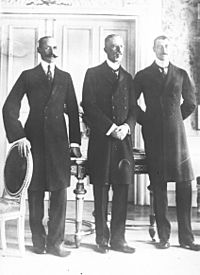
When Gustaf V became king, he had a lot of power. The old rules said the king was both the head of state and the head of government. Ministers only answered to him. However, his father had already started to accept that the government should be chosen by the majority in Parliament.
Early in his reign, Gustaf V seemed to accept this new way of doing things. In 1911, he appointed Karl Staaff, a Liberal leader, as Prime Minister.
The Courtyard Speech and Change
Before World War I, there was a debate about Sweden's defenses. In 1914, many farmers gathered at the royal palace. They wanted the country's military to be stronger. Gustaf V gave a speech, known as the Courtyard Speech, promising to improve defenses. This speech made Prime Minister Staaff angry. He felt the king should not get involved in politics without consulting him.
Gustaf V said he had the right to speak freely to the Swedish people. Staaff's government resigned because of this disagreement. Gustaf then appointed a new government led by Hjalmar Hammarskjöld.
Parliamentary Democracy Takes Hold
In 1917, elections showed that the Liberals and Social Democrats had a strong majority in Parliament. Gustaf V first tried to appoint a Conservative government. But it became clear he could no longer choose a government that Parliament didn't support.
So, he appointed a government led by Nils Edén, a Liberal. This new government quickly took most of the king's political powers. They also made big changes, like giving all men and women the right to vote by 1919.
Even though Gustaf V still formally appointed ministers, they now had to have the support of Parliament. He had to follow their advice. This meant that the ministers were now truly in charge of governing the country. Gustaf V accepted this new, smaller role. He continued to be a respected symbol of the nation's unity for the rest of his life.
Gustaf V During World Wars
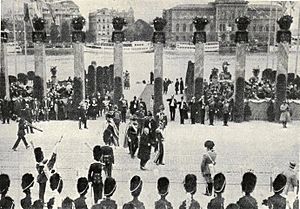
Gustaf V was thought to have some sympathy for Germany during World War I. His wife, who was German, also felt a strong connection to her homeland. In 1914, he hosted a meeting with the kings of Denmark and Norway in Malmö. This meeting was to show that the Scandinavian countries were united and to assure others that Sweden would stay neutral.
Even with less political power, Gustaf V still had some influence. In 1938, he told the German ambassador that if Hitler attacked Czechoslovakia, it would start a world war that Germany would likely lose.
World War II and Swedish Neutrality
During World War II, Sweden remained neutral. In June 1941, when Nazi Germany invaded the Soviet Union, Gustaf V wanted to send a letter to Hitler. He wanted to thank Hitler for fighting against the "Bolshevik pest." However, Prime Minister Per Albin Hansson stopped him from sending it.
There was a big event in 1941 called the "Midsummer Crisis." It is said that the King threatened to step down if the government did not let German troops travel through Sweden. This was a request from Nazi Germany to move a German army division from Norway to Finland. This event is still talked about by historians. German documents from the war confirm that the King did tell Germany that the troop movement would be allowed.
A King of Sports
Gustaf V was very tall and thin. He was known for wearing pince-nez glasses and having a pointed mustache.
He was a very enthusiastic tennis player. He played under the name Mr G. He was so good and did so much to promote the sport that he was put into the International Tennis Hall of Fame in 1980. He learned tennis in Britain in 1876. When he came back to Sweden, he started the country's first tennis club. In 1936, he founded the King's Club.
Gustaf V continued to play competitive tennis even into his 80s. He was often seen playing on the French Riviera. He even played a tennis match with a Jewish player, Daniel Prenn, right after meeting with Hitler in Berlin. During World War II, he helped get better treatment for tennis stars who had been imprisoned.
Death
King Gustaf V died in Stockholm on 29 October 1950, after ruling for almost 43 years. He was 92 years old. His son, Gustaf VI Adolf, became the new king.
Issue
| Name | Birth | Death | Notes |
|---|---|---|---|
| Gustaf VI Adolf of Sweden | 11 November 1882 | 15 September 1973 | Became King of Sweden. Married 1) Princess Margaret of Connaught, had children. Married 2) Lady Louise Mountbatten, had a stillborn daughter. |
| Prince Wilhelm, Duke of Södermanland | 17 June 1884 | 5 June 1965 | Married Grand Duchess Maria Pavlovna of Russia, had children. |
| Prince Erik, Duke of Västmanland | 20 April 1889 | 20 September 1918 | Died unmarried from the Spanish flu. |
Honours
Gustaf V received many honours and awards during his life. Here are some of the most important ones:
- Knight and Commander of the Seraphim (Sweden)
- Knight of the Order of Charles XIII (Sweden)
- Commander Grand Cross of the Sword (Sweden)
- Commander Grand Cross of the Polar Star (Sweden)
- Commander Grand Cross of the Order of Vasa (Sweden)
- Knight of the Elephant (Denmark)
- Stranger Knight of the Garter (United Kingdom)
- Grand Cordon of the Chrysanthemum (Japan)
Arms
When he was made Duke of Värmland, Gustaf V was given a special coat of arms. When he became king, he used the official Coat of Arms of Sweden.
See also
 In Spanish: Gustavo V de Suecia para niños
In Spanish: Gustavo V de Suecia para niños


